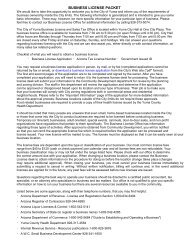Water Quality Report - City of Yuma, Arizona
Water Quality Report - City of Yuma, Arizona
Water Quality Report - City of Yuma, Arizona
- No tags were found...
You also want an ePaper? Increase the reach of your titles
YUMPU automatically turns print PDFs into web optimized ePapers that Google loves.
Substances That Could Be in <strong>Water</strong>To ensure that tap water is safe to drink, <strong>Arizona</strong>Department <strong>of</strong> Environmental <strong>Quality</strong> prescribesregulations limiting the amount <strong>of</strong> certain contaminantsin water provided by public water systems. U.S. Foodand Drug Administration regulations establish limitsfor contaminants in bottled water. Drinking water,including bottled water, may reasonably be expected tocontain at least small amounts <strong>of</strong> some contaminants.The presence <strong>of</strong> these contaminants does not necessarilyindicate that the water poses a health risk.The sources <strong>of</strong> drinking water (both tap water andbottled water) include rivers, lakes, streams, ponds,reservoirs, springs, and wells. As water travels over thesurface <strong>of</strong> the land or through the ground, it dissolvesnaturally occurring minerals, in some cases, radioactivematerial, and substances resulting from the presence<strong>of</strong> animals or from human activity. Contaminants thatmay be present in source water include:Microbial Contaminants, such as viruses and bacteria,which may come from sewage treatment plants, septicsystems, agricultural livestock operations, or wildlife;Inorganic Contaminants, such as salts and metals,which can be naturally occurring or may result fromurban stormwater run<strong>of</strong>f, industrial or domesticwastewater discharges, oil and gas production, mining,or farming;Pesticides and Herbicides, which may come from avariety <strong>of</strong> sources such as agriculture, urban stormwaterrun<strong>of</strong>f, and residential uses;Organic Chemical Contaminants, including syntheticand volatile organic chemicals, which are by-products <strong>of</strong>industrial processes and petroleum production and mayalso come from gas stations, urban stormwater run<strong>of</strong>f,and septic systems;Radioactive Contaminants, which can be naturallyoccurring or may be the result <strong>of</strong> oil and gas productionand mining activities.More information about contaminants in tap waterand potential health effects can be obtained by callingthe Environmental Protection Agency’s Safe Drinking<strong>Water</strong> Hotline at (800) 426-4791 or visit online atwww.epa.gov/safewater/hotline. Information on bottledwater can be obtained from the U.S. Food and DrugAdministration.










